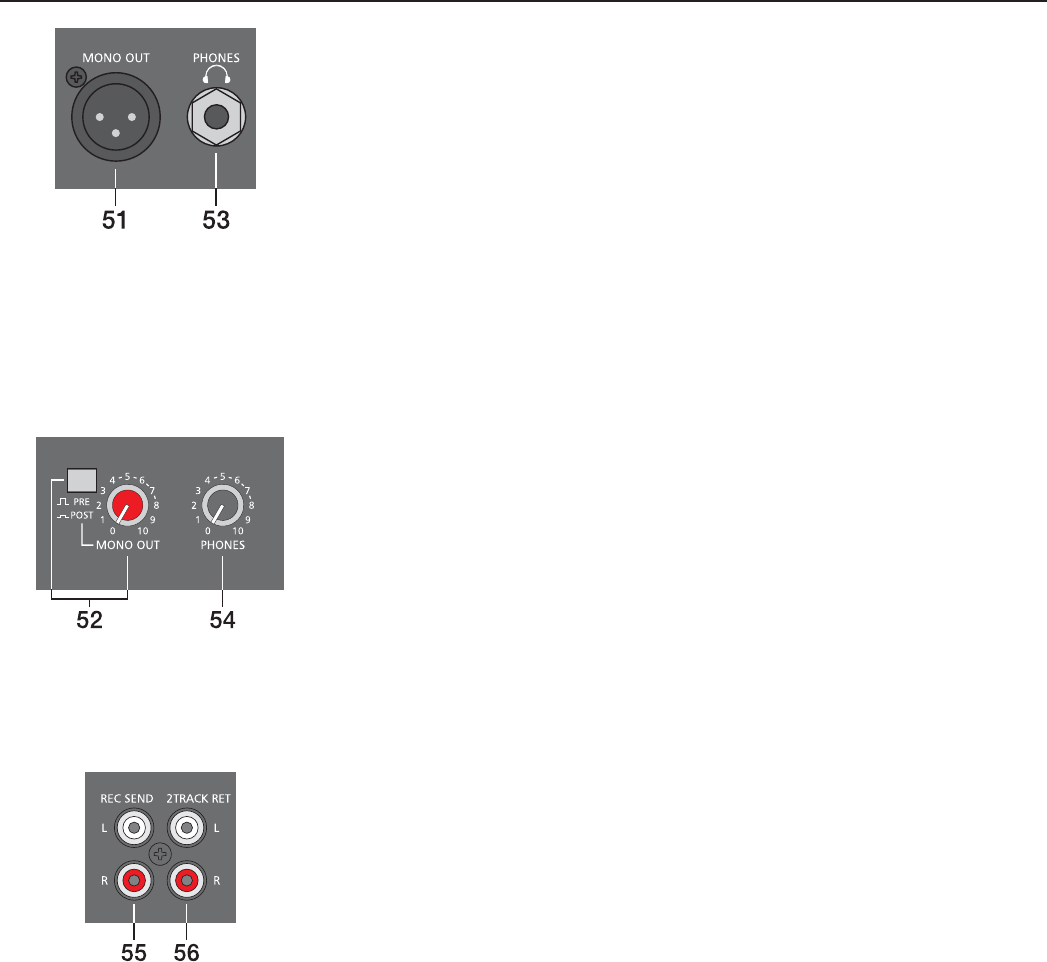
MASTER
51. MONO OUTPUT
At this electronically balanced monaural output the summed L/R master audio signal is
present and can be used for additional monitoring, side fi ll and “next door” or Mono-PA
applications as well as for the connection of a delay-line or subwoofer. The MONO OUTPUT
– like any other XLR-type outputs on the CMS – is switched via output relay with a delay of
approx. two seconds after the mixer has been powered on, which prevents power-on noise
when switching the mixer on or off.
52. MONO OUT LEVEL & PRE/POST
This control allows setting the MONO OUT’s output level.
With subwoofer operation, “next-door”, monitoring or delay line applications a pre/post-
switch able mono output often comes in handy.
PRE-FADER: The mono out’s signal is summed and outputted pre master faders.
The level at the mono out is independent from the master faders’ settings.
POST-FADER: The mono out’s signal is summed and outputted post master faders.
The level at the mono out depends on the setting of the master faders.
Of course, controlling the SUB’s level via master fader makes sense when using an active
monaural subwoofer. For monitoring applications, e.g. side fi ll on the stage, using the pre-
fader setting seems more reasonable.
53. PHONES STEREO phone-type jack for the connection of headphones with impedances
of 32 - 600 ohms. The audio signals of the channels with PFL buttons engaged are outputted
via this connector.
The phones output presents the master L/R signal when there is no PFL button engaged.
54. PHONES LEVEL
This control sets the volume of the headphones connected.
CAUTION: Make sure to set the control to its minimum position before connecting
headphones.
55. RECORD SEND L/R
These RCA-type connectors carry the PRE FADER master L/R signals, which are not
affected by the setting of the master faders and therefore mostly used for the connection of
cassette decks, open reel tape decks or DAT recorders for recording purposes. The nominal
level of the outputs is –10dBV and matches the professional industry standard as well as
most home recording applications. However, you should use the input gain control of your
recording device - as far as it is provided.
CAUTION: On many tape decks the input signal is directly carried through to the outputs.
In case you have connected both, REC SEND and 2TRACK RETURN, and the 2TRACK
to MASTER control of the CMS is set to anything but its lowest setting, the recorded signal
is included in the main mix again. The difference in delay of the two signals is responsible
for dropouts and general degradation in sound. In the worst case, activating the RECORD
button on your tape deck could lead to very unpleasant feedback noise. To prevent this
from happening make sure to set the 2TRACK to MASTER and the AUX3/4 controls to their
lowest settings (all the way counterclockwise).
56. 2TRACK RETURN L/R
Here you can connect tape decks, CD players, open reels or an additional SUB-mixer. The
signal is post master fader and post STANDBY switch, which allows playing intermission
music during performance breaks or checking the mix during rehearsals, using the
headphones. You just have to engage the STANDBY switch to mute all channel signals at
the main outputs. The 2TRACK RETURN signal however will pass unobstructed.
18


















